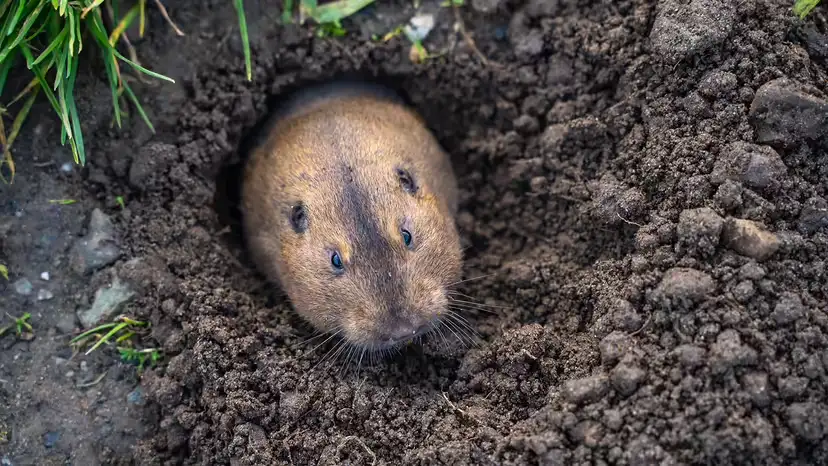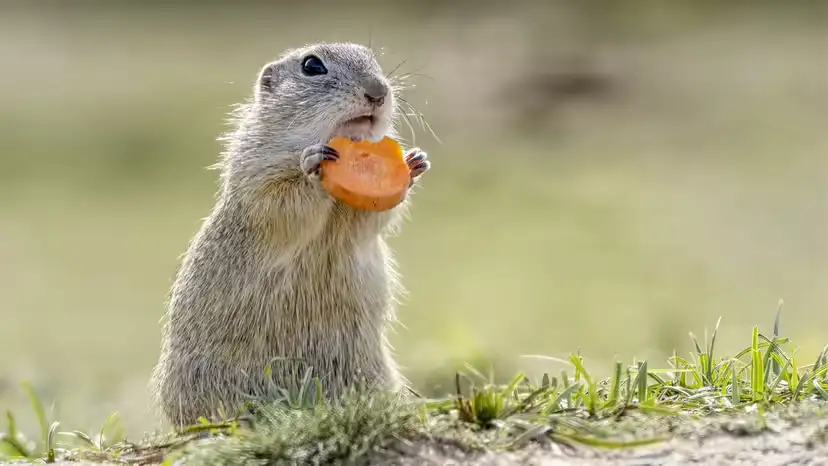Spot a chunky, dirt-moving mammal and wondering which burrower you’re dealing with? Groundhogs and gophers both remodel lawns and raid gardens, but they’re different animals with different behaviors. Knowing which one you have makes control far more effective.

Groundhogs (also called woodchucks) are sciurids—the squirrel family—while gophers are geomyids, a separate rodent family. That split shows up in their bodies and how they use your yard.
Groundhogs are stout and much larger, commonly 7–13 lb (3–6 kg), with a rounded head, visible ears, and a bushy, medium-length tail. Their incisors are big but typically tucked inside the lips when the mouth is closed.
Gophers are compact, typically under 2 lb (~1 kg), with tiny ears, tiny eyes, and a short, hairless tail. Their incisors protrude even when the mouth is closed, and pocket gophers have fur-lined cheek pouches they stuff with roots and stems.
Groundhogs blanket the eastern and central United States into southern Canada and parts of Alaska, thriving along field edges, pastures, road banks, and woodland margins.
Gophers dominate western and Great Plains states and extend through grasslands and irrigated farm country in North and Central America, favoring deep, friable soils that are easy to excavate.

Groundhog dens are deep, roomy, and fewer in number, with round entrances 6–10 inches across, often at a fencerow or hedgerow, and a conspicuous fan of excavated soil. Secondary “bolt holes” may be hidden in grass. Burrows can stretch 25–50 feet with chambers for resting and rearing young.
Gopher systems are shallow but expansive, like an underground lattice of feeding runs with many plugged openings. At the surface you’ll see fresh crescent- or horseshoe-shaped mounds of fine soil, usually no open hole visible because gophers plug it from below. Mounds often align in chains across a lawn or field.
Groundhogs are daytime foragers that waddle out to graze clover, alfalfa, tender perennials, vegetable beds, and even low shrub branches. Plants are clipped cleanly above ground, and you may catch a groundhog sunning on a soil pile or darting to a den when spooked. Late summer and fall bring a feeding surge before winter hibernation.
Gophers are subterranean specialists. They pull plants down from below, leaving chewed crowns, missing seedlings, and roots snipped off under the soil. New mounds appear overnight as they push spoil up from fresh tunnels. Most species remain active year-round and rarely show themselves topside.
| Feature | Groundhog (Woodchuck) | Gopher (Pocket gopher) |
|---|---|---|
| Family | Sciuridae (squirrels) | Geomyidae |
| Adult size | 7–13 lb, stocky | < 2 lb, compact |
| Tail | Bushy, mid-length | Short, mostly hairless |
| Ears & eyes | Ears visible, larger eyes | Ears tiny, eyes beady |
| Teeth at rest | Usually inside lips | Incisors protrude |
| Burrow openings | Round, 6–10 in, open | Small, plugged; mound nearby |
| Mounds | Irregular fan of soil | Crescent/Horseshoe mounds in series |
| Foraging | Above ground, daytime | Below ground, pulls plants down |
| Seasonality | Hibernates in winter | Typically active year-round |
If you’re seeing above-ground grazing, broad holes, and a visible animal, plan for groundhog exclusion: sturdy hardware-cloth fencing 3–4 feet high, buried 10–12 inches with the bottom edge bent outward as an L-shaped footer, plus tight gates and cleared vegetation near fences. Den entry points can be excluded only after you’re certain the burrow is vacant, especially in baby season.
If you’re finding fresh crescent mounds in strings and plants vanishing from below, it’s gophers. Targeted controls include underground barriers (¼- to ½-inch hardware cloth around beds, 18–24 inches deep), trap placement in the main tunnel just beyond a fresh mound, and reducing attractants like unprotected root crops. Because gophers rarely surface, surface fencing alone won’t help.

See a big brown mammal loafing by a round hole in daylight with a broom-tail and visible ears—think groundhog. See overnight mounds shaped like a side-ways C or horseshoe, no open hole, and plants disappearing from the root zone—think gopher.
Correct ID first, then choose the fitting fix. Your lawn—and your vegetables—will thank you.
animal tags: gopher vs groundhog
We created this article in conjunction with AI technology, then made sure it was fact-checked and edited by a Animals Top editor.